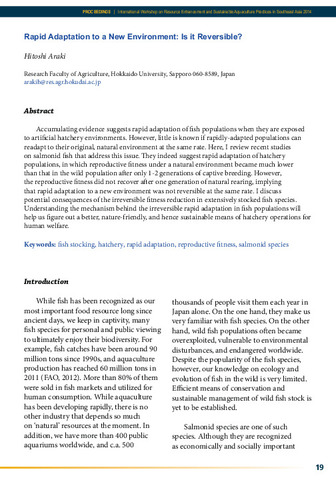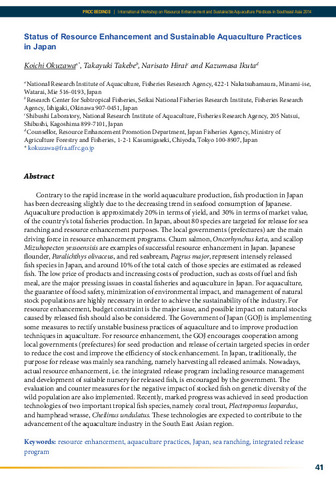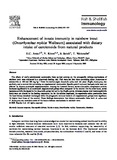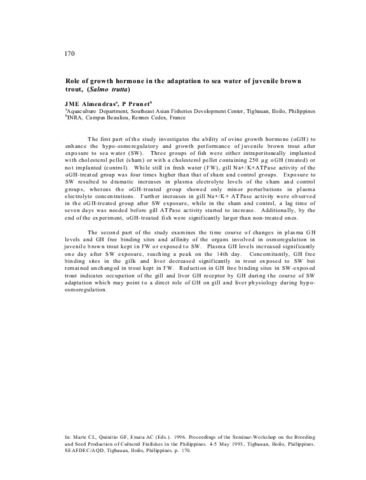Rapid adaptation to a new environment: is it reversible?
Share
abstrak
Accumulating evidence suggests rapid adaptation of fish populations when they are exposed to artificial hatchery environments. However, little is known if rapidly-adapted populations can readapt to their original, natural environment at the same rate. Here, I review recent studies on salmonid fish that address this issue. They indeed suggest rapid adaptation of hatchery populations, in which reproductive fitness under a natural environment became much lower than that in the wild population after only 1-2 generations of captive breeding. However, the reproductive fitness did not recover after one generation of natural rearing, implying that rapid adaptation to a new environment was not reversible at the same rate. I discuss potential consequences of the irreversible fitness reduction in extensively stocked fish species. Understanding the mechanism behind the irreversible rapid adaptation in fish populations will help us figure out a better, nature-friendly, and hence sustainable means of hatchery operations for human welfare.
Suggested Citation
Araki, H. (2015). Rapid adaptation to a new environment: is it reversible? In M. R. R. Romana-Eguia, F. D. Parado-Estepa, N. D. Salayo, & M. J. H. Lebata-Ramos (Eds.), Resource Enhancement and Sustainable Aquaculture Practices in Southeast Asia: Challenges in Responsible Production of Aquatic Species: Proceedings of the International Workshop on Resource Enhancement and Sustainable Aquaculture Practices in Southeast Asia 2014 (RESA) (pp. 19-24). Tigbauan, Iloilo, Philippines: Aquaculture Dept., Southeast Asian Fisheries Development Center.
Subjek
Adaptations; breeding  ; Anadromous species; behaviour
; Anadromous species; behaviour  ; stocks
; stocks  ; culture effects
; culture effects  ; reproduction
; reproduction  ; reproductive behaviour
; reproductive behaviour  ; cultured organisms
; cultured organisms  ; fish culture
; fish culture  ; hatcheries
; hatcheries  ; Salmo trutta; Oncorhynchus gorbuscha; Oncorhynchus mykiss; Salmonidae; Oncorhynchus tshawytscha; Oncorhynchus kisutch; Fish stocking; Rapid adaptation; Reproductive fitness; Salmonid species
; Salmo trutta; Oncorhynchus gorbuscha; Oncorhynchus mykiss; Salmonidae; Oncorhynchus tshawytscha; Oncorhynchus kisutch; Fish stocking; Rapid adaptation; Reproductive fitness; Salmonid species
 ; Anadromous species; behaviour
; Anadromous species; behaviour  ; stocks
; stocks  ; culture effects
; culture effects  ; reproduction
; reproduction  ; reproductive behaviour
; reproductive behaviour  ; cultured organisms
; cultured organisms  ; fish culture
; fish culture  ; hatcheries
; hatcheries  ; Salmo trutta; Oncorhynchus gorbuscha; Oncorhynchus mykiss; Salmonidae; Oncorhynchus tshawytscha; Oncorhynchus kisutch; Fish stocking; Rapid adaptation; Reproductive fitness; Salmonid species
; Salmo trutta; Oncorhynchus gorbuscha; Oncorhynchus mykiss; Salmonidae; Oncorhynchus tshawytscha; Oncorhynchus kisutch; Fish stocking; Rapid adaptation; Reproductive fitness; Salmonid species
Related items
Showing items related by title, author, creator and subject.
-
Status of resource enhancement and sustainable aquaculture practices in Japan
Okuzawa, Koichi; Takebe, Takayuki; Hirai, Narisato; Ikuta, Kazumasa (Aquaculture Department, Southeast Asian Fisheries Development Center, 2015)Contrary to the rapid increase in the world aquaculture production, fish production in Japan has been decreasing slightly due to the decreasing trend in seafood consumption of Japanese. Aquaculture production is approximately ... -
Enhancement of innate immunity in rainbow trout (Oncorhynchus mykiss Walbaum) associated with dietary intake of carotenoids from natural products
Amar, Edgar C.; Kiron, V.; Satoh, S.; Watanabe, T. (Elsevier, 2004)The effects of orally administered carotenoids from natural sources on the non-specific defense mechanisms of rainbow trout were evaluated in a nine-week feeding trial. Fish were fed four diets containing either β-carotene ... -
Role of growth hormone in the adaptation to sea water of juveline brown trout, (Salmo trutta)
Almendras, J. M. E.; Punet, P. (Aquaculture Department, Southeast Asian Fisheries Development Center, 1996)The first part of the study investigates the ability of ovine growth hormone (oGH) to enhance the hypo-osmoregulatory and growth performance of juvenile brown trout after exposure to sea water (SW). Three groups of fish ...




